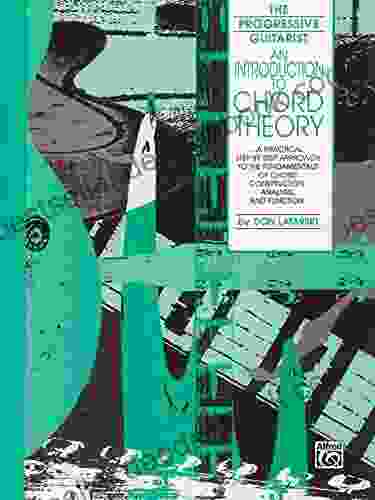An In-Depth Introduction to Chord Theory: Exploring the Building Blocks of Music

Music, an art form that transcends cultures and time, is composed of various elements, including rhythm, melody, harmony, and timbre. Among these elements, chords play a pivotal role in creating the underlying structure and emotional impact of music. Chord theory, therefore, is an essential foundation for musicians, composers, and anyone seeking to understand the intricate tapestry of music.
What is a Chord?
In music, a chord is defined as a group of three or more notes played simultaneously. These notes are typically chosen from a particular scale or key and are arranged in a specific order to create a pleasing and coherent sound. Chords provide the harmonic framework that supports the melody and adds depth to the overall musical texture.
4.7 out of 5
| Language | : | English |
| File size | : | 2153 KB |
| Text-to-Speech | : | Enabled |
| Screen Reader | : | Supported |
| Word Wise | : | Enabled |
| Print length | : | 48 pages |
Types of Chords
Chord theory classifies chords based on their construction and the intervals between their notes. Common chord types include:
* Triads: The most fundamental type of chord, consisting of three notes: root, third, and fifth. * Seventh Chords: An extension of triads that add a seventh note, creating a richer and more complex sound. * Ninth, Eleventh, and Thirteenth Chords: Further extensions of the seventh chord, adding additional intervals to create even more harmonic depth. * Sus Chords: Replace the third in a triad with the second or fourth to create a suspended sound that resolves into a traditional triad. * Inversions: Chords can be inverted by rearranging the order of the notes, placing the third, fifth, or seventh in the bass.
Chord Progressions
Chord progressions are sequences of chords that provide direction and flow to a musical piece. They create a sense of movement and forward motion, leading the listener through different harmonic landscapes. Chord progressions can be harmonically stable or unstable, creating tension and release that adds drama and interest to music.
Building Chords
Building chords involves understanding intervals and the principles of voice leading. Intervals are the distance between two notes, measured in semitones. Voice leading refers to the smooth and logical movement of individual notes in a chord progression. By carefully selecting intervals and ensuring proper voice leading, composers can create chords that are sonorous, pleasing to the ear, and effective in supporting the melody.
Chord Notation
Chords are typically notated using Roman numerals (I, IV, V) or chord symbols (C maj, G7, Dm). Roman numerals indicate the root note of the chord in relation to the key of the piece, while chord symbols provide more specific information about the chord type, inversion, and any added notes. Proper chord notation is essential for clear and effective communication between musicians.
Chord Theory in Practice
Chord theory is an integral part of music theory and practice. It finds practical applications in:
* Composition: Composers use chord theory to create harmonic foundations for melodies, establish key centers, and generate chord progressions that evoke specific moods and emotions. * Arranging: Arrangers reharmonize and reinterpret existing melodies by applying chord theory principles to add harmonic depth and interest. * Improvisation: Chord theory provides a framework for improvisers to explore harmonic possibilities and create spontaneous melodies over chord progressions. * Music Analysis: Musicians analyze chord sequences to understand the structure, function, and emotional impact of music. * Education: Chord theory is taught in music schools, conservatories, and online resources, providing musicians with the knowledge and skills to master harmony.
Chord theory is an essential aspect of music theory and practice, offering a systematic approach to understanding the harmonic structure of music. By studying chord construction, progressions, and notation, musicians can unlock the secrets of harmony and create rich and meaningful musical experiences. From composing unforgettable melodies to improvising with confidence, chord theory empowers musicians to express themselves creatively and connect with audiences on a visceral level.
4.7 out of 5
| Language | : | English |
| File size | : | 2153 KB |
| Text-to-Speech | : | Enabled |
| Screen Reader | : | Supported |
| Word Wise | : | Enabled |
| Print length | : | 48 pages |
Do you want to contribute by writing guest posts on this blog?
Please contact us and send us a resume of previous articles that you have written.
 Novel
Novel Page
Page Text
Text Library
Library E-book
E-book Newspaper
Newspaper Sentence
Sentence Bookmark
Bookmark Shelf
Shelf Bibliography
Bibliography Foreword
Foreword Preface
Preface Synopsis
Synopsis Footnote
Footnote Manuscript
Manuscript Bestseller
Bestseller Classics
Classics Biography
Biography Memoir
Memoir Encyclopedia
Encyclopedia Narrator
Narrator Resolution
Resolution Librarian
Librarian Catalog
Catalog Card Catalog
Card Catalog Borrowing
Borrowing Stacks
Stacks Archives
Archives Lending
Lending Reserve
Reserve Journals
Journals Reading Room
Reading Room Special Collections
Special Collections Interlibrary
Interlibrary Literacy
Literacy Study Group
Study Group Thesis
Thesis Storytelling
Storytelling Awards
Awards Reading List
Reading List Alison Peirse
Alison Peirse Kitten Fisher
Kitten Fisher L P Dover
L P Dover Samanthi Fernando
Samanthi Fernando Sinan Ozdemir
Sinan Ozdemir William Cheng
William Cheng Gina Ogden
Gina Ogden Mangey Ram
Mangey Ram Allan B Cobb
Allan B Cobb Dezi Shepperd
Dezi Shepperd Paul Francis Kildea
Paul Francis Kildea Dr Lew Deitch
Dr Lew Deitch Carolyn Jefferson Jenkins
Carolyn Jefferson Jenkins John Meyer
John Meyer Franklin W Dixon
Franklin W Dixon David Malet
David Malet Georg Eisner
Georg Eisner James Inverne
James Inverne Therese Anne Fowler
Therese Anne Fowler Iain Ellwood
Iain Ellwood
Light bulbAdvertise smarter! Our strategic ad space ensures maximum exposure. Reserve your spot today!
 Jake CarterFollow ·11.7k
Jake CarterFollow ·11.7k Floyd RichardsonFollow ·19.1k
Floyd RichardsonFollow ·19.1k Mason PowellFollow ·7k
Mason PowellFollow ·7k José MartíFollow ·18.6k
José MartíFollow ·18.6k Grayson BellFollow ·14.5k
Grayson BellFollow ·14.5k Eric NelsonFollow ·17.6k
Eric NelsonFollow ·17.6k Hudson HayesFollow ·4.6k
Hudson HayesFollow ·4.6k Tyler NelsonFollow ·12.3k
Tyler NelsonFollow ·12.3k

 Brian Bell
Brian BellClassic Festival Solos Bassoon Volume Piano...
The Classic Festival Solos Bassoon Volume...

 Aubrey Blair
Aubrey BlairUnveiling the Courage: Insurgent Women Female Combatants...
In the face of armed...

 Jan Mitchell
Jan MitchellFor The Liberty Of Texas: The Lone Star State's Fight for...
The Republic of Texas was a sovereign state...

 Edgar Allan Poe
Edgar Allan PoeVisible, Explainable, Trustworthy, and Transparent...
What is VET2...
4.7 out of 5
| Language | : | English |
| File size | : | 2153 KB |
| Text-to-Speech | : | Enabled |
| Screen Reader | : | Supported |
| Word Wise | : | Enabled |
| Print length | : | 48 pages |
















